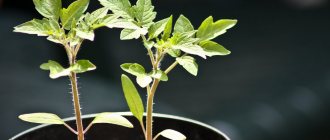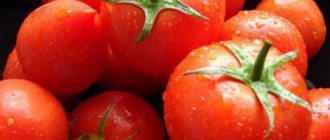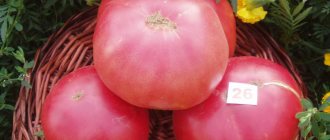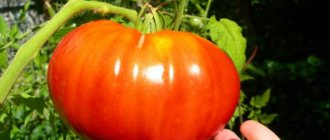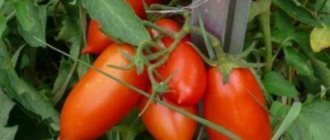Description of the variety
Description of the variety:
Fruits:
- It has an oval, ovoid shape;
- Of red color;
- With smooth, dense skin, not prone to cracking;
- With a small amount of seeds;
- Number of seed chambers up to 3;
- Dry matter content from 4 to 5%;
- Sugar content approximately 2.5%;
- With a sweetish and slightly sour taste, it has a pronounced tomato aroma;
Average weight is 130 grams.
Bushes:
- Determinate type, compact, with average formation of green mass;
- Height ranges from 50 to 55 cm;
- The leaves are medium in size, typical tomato shape, light emerald in color;
- Inflorescence of simple type. The formation of the first is carried out over leaves 3-5;
- The stalk has no articulation.
Description of the Kokhava tomato and characteristics of the variety
Tomato Kokhava f1 is an indeterminate hybrid, which was bred by Russian breeders. A positive characteristic of the variety is its high yield and early ripening. The plant is characterized by good immunity and is resistant to many diseases.
Plant characteristics
Kohava is a hybrid that is also indeterminate and quite tall. The plant has medium leaves that are dark green in color and forms a strong root system. The tomato has simple inflorescences; on average, 5-6 tomatoes are formed on one ovary.
Due to its parameters and characteristics, the plant is characterized by a good immune system and is not afraid of diseases such as late blight. But at the same time, damage from external pests cannot be ruled out. Therefore, if damage to the trunk and leaves from pests is noticeable, it is better to treat the plant with a weak solution of manganese.
The downside of the plant is that it is a hybrid, so getting seeds for next year to grow seedlings will be quite a painstaking task.
Description of the fruit
The fruits have a flat-round shape and a pale pink color. The average weight of a ripe fruit is 150 grams. On average, 5-6 fruits ripen on one cluster. The weight and size of a tomato depends on the number of tomatoes ripening on the bush. The fruit has a bright red color and an interesting shape.
Vegetables of this variety are characterized by good keeping quality and are convenient to transport over long distances. This variety is not characterized by cracking. In this case, the tomato will not lose its presentation.
If you store vegetables in a cool place, they can last for a long time. Tomatoes can be used both for fresh consumption and for preservation. The rather large fruit makes it possible to effectively use tomatoes for tomato juice.
How is sowing done?
The tomato is a hybrid, so the seeds must be purchased at a specialty store. Before planting seeds, it is necessary to prepare the soil and treat the seeds with manganese. This must be done to prevent future tomatoes from contracting the disease. The seeds are sown to a depth of 2 cm and the box must be placed in a warm and sunny place.
After the seeds have hatched, after the first leaf it is necessary to prick the seedling in order for it to strengthen. Plants must be planted when they are 55 days old. To obtain earlier fruits, you can plant seedlings in a greenhouse. Care consists of regular watering, loosening the soil and fertilizing the plant. On average, there are 3 adult plants per 1 square meter. In these growing conditions they will feel comfortable and bear fruit.
Features of the variety
Peter 1 is a mid-early vegetable. The growing season is 105-110 days. But in cloudy weather it increases to 115-120. The crop is cultivated in open space and under film. With good lighting, it can grow in a greenhouse. One bush gives 2.5 kg. tomatoes, and a square of land - 10 kg.
The plants are determinate, tall, have medium foliage, and have regular leaf blades. The first simple inflorescence is formed above the 3rd leaf or higher. The peduncle is not articulated.
Fruit
The weight of the tomato is 200-250 g. They have a flat-round shape, fleshy, durable, and do not crack. The bright red fruits are firmly attached to the stalk.
The chamber for a few seeds includes 3 nests. The fruits are very tasty, contain 2.5% sugar and 4-5% dry matter. They have a pronounced tomato aroma and a sweet, slightly sour taste.
According to the description of the tomato by Peter 1, its meaning is universal. The vegetable is consumed fresh, canned, processed, added to salads, snacks, caviar, purees, made into paste, marinades, juice and jam. Unripe green or brown tomatoes are salted. They can also be stored next to red ones for ripening.
Forced ripening has been used for a long time. Pink, brown green and blanzhe fruits are placed in two or three rows in wooden boxes. Between them there should be several ripe, healthy and not deformed tomatoes. After a certain time, unripe tomatoes will turn red. This does not affect the taste.
Green fruits can remain separated from mature ones for 2 months. They need to be placed loosely in a container and placed in a cellar or other dark place with a temperature of 5-8 degrees Celsius.
Subtleties of cultivation
Full-bodied, smooth seeds of a characteristic shape that do not have an unpleasant odor are sown on seedlings. Tomato flavor is allowed. The optimal sowing time is 56-60 days before the planned planting in the ground. Some running time is allowed, since suitable weather conditions for planting seedlings in the garden bed may occur earlier or later than usual.
Seedlings can be grown with or without picking. In the second case, seeds are sown immediately in 3-4 pieces. into separate pots or cassettes, and then remove weak shoots, leaving 1 or 2 strong plants. To save space, some gardeners grow 2 plants in each container, but everything is better when they grow one at a time, so the seedlings will definitely not lack light, water and minerals.
Hardening
The seedlings are hardened by gradually lowering the ambient temperature to 8-10 degrees. You can also keep pots or boxes in the yard during the day and bring them indoors at night. The main thing is that the leaves do not get sunburned. There are two ways to prevent such a nuisance: gradually increase the time the plants stay outside or simply place them under a canopy.
How to distinguish hardened seedlings
Reviews about the Peter the Great tomato confirm that the yield from “our own” seedlings is higher, but not everyone has the opportunity to grow it
If bushes are purchased on the market, you need to pay attention to their appearance
Hardened bushes are easy to identify: they are stocky, strong, with dark green leaves.
Seedlings that grow in warm, low-light conditions are usually elongated, pale green, and look pampered. This is undesirable for early and mid-early low-growing varieties. If the late ones have time to compensate for the lag in growth and gain strength, then the middle ones do not have much of it.
Important! If you plant frail, weak seedlings, you may not expect a good harvest.
Now no one doubts the benefits of hardening, but when growing seedlings for sale, this measure is usually neglected. Hardened specimens adapt better to changing weather conditions, tolerate cold and heat more easily, are more resistant to diseases and are not so damaged by pests. For obvious reasons, they also produce more harvest.
Nutrition when growing seedlings
The correct ratio of nutrients, along with optimal lighting, temperature and humidity, can significantly accelerate the development of seedlings. First of all, you need to know the acidity of the substrate: if it is below 5.0, then 1.5 kilograms of lime are added per 1 cubic meter of peat.
It must be borne in mind that young seedlings do not absorb phosphorus well from an environment with a low concentration of this element. If phosphorus fertilizers are not applied, the seedlings will be stunted in growth, their leaves and stems will become dark purple in color.
Seedlings develop more slowly, flowering and ripening are delayed.
It is better to apply superphosphate in granular form, 40-50 grams per seed box (50X35 centimeters in size and 10 centimeters deep). The fertilizer must be thoroughly mixed with peat.
In greenhouses, where the soil layer reaches 10-13 cm, 400-500 grams of superphosphate are needed per frame. It must be scattered evenly throughout the entire layer.
It is advisable to add potassium fertilizers to potassium-poor peat: potassium sulfate or potassium chloride, or ash. The dose of the first two is up to 10 grams per seed box and 50 grams per frame.
Wood ash from stoves gives the best results.
It contains not only potassium, but also calcium and trace elements (copper, boron, manganese, zinc, cobalt and others), which are also needed by plants in small quantities.
Ash can be applied 2 times more than industrial mineral fertilizers - 20 grams per box and 100 grams per frame.
Nitrogen nutrition of plants in the seedling phase should be very moderate. With an abundant supply of nitrogen, the seedlings stretch out, which subsequently leads to a delay in the flowering and ripening of tomatoes. In addition, excess nitrogen fertilizers cause oppression of plants in the first days of their life. In a well-ventilated peat mass at optimal temperature and humidity, the processes of ammonification and nitrification proceed intensively, resulting in the formation of a large amount of nitrogen in forms accessible to plants, quite sufficient for the normal development of seedlings. Therefore, there is no need to add nitrogen fertilizers to the peat or the mixture of soil and humus.
So, enhanced phosphorus-potassium and moderate nitrogen nutrition of plants in the seedling phase helps accelerate their development,
It is recommended to sow seeds in rows at a distance of 4-5 centimeters from one another. They should be spaced 1.5-2 centimeters apart. The embedment depth is 2-2.5 centimeters. After sowing, the soil must be watered with warm water in a gentle stream so as not to wash out the seeds.
Description of the Tsar Peter tomato variety and its characteristics
The Tsar Peter tomato is a varietal species and is not a hybrid. The variety was bred for cultivation in open ground or under a light film covering. The characteristics and description of the variety will be presented below. It will also talk about the main positive and negative qualities of the Tsar Peter variety. And according to vegetable growers who have been growing these tomatoes for several seasons, this vegetable is the king among all other types of tomatoes.
Description and main characteristics of the variety
The bushes of this variety are of the determinate type, not standard, compact. The shoots are erect, low - no higher than 0.5 m, medium-leafy. The foliage is medium in size, typically tomato, light emerald in color.
Tsar Peter is a medium-early ripening tomato: from the moment of friendly shoots to harvest, about 4 months pass.
The inflorescences are simple, the first of them is usually formed above the third permanent leaf, and the subsequent ones appear after 1-2 leaves. In total, up to 5-6 ovaries can appear on one shoot.
The fruits are flat-round, the flesh is fleshy. The skin is dense, smooth, without ribbing, and not prone to cracking. Ripe tomatoes are bright red in color. They are held tightly on the stalks. The stalks have no articulations. The weight of one tomato can reach 0.25 kg, but most ripening tomatoes usually reach 200 grams. Up to 3 kg of fruits are usually collected from one bush. Up to 4 bushes are planted per 1 m², so 10-11 kg of crop is harvested per square meter.
The description of the variety will be incomplete without talking about the resistance of these tomatoes to major diseases. Tsar Peter is highly resistant to fungal diseases, in particular late blight, which the plant does not have time to get sick due to the relatively early ripening of tomatoes.
The seed chambers of ripe fruits consist of two or three nests, which do not contain many seeds. The juice contains an increased amount of sugar - about 2.4%, and dry matter - up to 5.4%. The taste of tomatoes is excellent - quite sweet with a pronounced tomato aroma.
The ripe fruits of Tsar Peter are universal: they are eaten fresh, in salads, canned, made into juices, sauces, purees, pastes and many other twists. Even unripe fruits can be salted and pickled.
If the fruits do not have time to ripen on the bushes, they can be placed to ripen in a warm room next to the red fruits.
The crop tolerates transportation well over fairly long distances and has excellent shelf life. Unripe fruits must be placed in boxes, separate from ripe tomatoes, in a cellar or other room where the temperature is maintained no higher than 5 degrees.
Pros and cons of the variety
The advantages of the Tsar Peter tomato include:
- high keeping quality;
- good resistance to major fungal diseases affecting tomatoes;
- good yield;
- compactness of bushes;
- universal purpose of ripened fruits;
- The crop tolerates transportation well over long distances.
But there are no negative qualities noted in this variety. Judging by the reviews of vegetable growers who grow this variety, compact, productive bushes do not require special care, take up little space in the beds, and therefore are very popular.
General view of the hybrid
Peter the Great F1 is a hybrid variety created by breeders specifically for cultivation in the Russian climate.
The plant looks like this:
- The tomato is an indeterminate type, that is, the stem grows continuously.
- The height of the central shoot is up to 170 cm.
- Average number of leaves. The plates have a shape characteristic of the bulk of tomatoes, small in size.
- The tomato plants its first inflorescence above the 6th or 7th leaf.
- The fruits resemble plums in appearance, which corresponds to the photo on the seed packaging. Average weight 80-90 g.
- Closer to ripeness they turn red.
- The variety by the same name is distinguished by large fruits (up to 250 g) of a round shape, as well as medium ripening times and a low bush (up to 80 cm).
According to ripening time | By type of growth | By type of use | By growing method | Fruit weight (g) | Yield (kg/m²) | Ripe fruit color | Fetal characteristics |
| Mid-early (95-100 days) | Indeterminant (up to 170-200 cm) | Pickling | For open ground and greenhouses | 80-90 | In a greenhouse - up to 15, in a garden bed - up to 10 | Red | Plumy, dense |
Diseases and pests
Tomato Leopold F1 is extremely resistant to fungi. Thanks to early ripening, it manages to avoid such a common disease among heat-loving plants as late blight. The reason for its appearance is most often the August night cold snap. Tomatoes do not tolerate high humidity and low temperatures. You should be wary of diseases such as:
- Tobacco mosaic. This viral disease is characterized by yellowing of leaves and fruits. The tomatoes become covered with yellow-brown stains and remain unripe. It is almost impossible to deal with mosaic. Therefore, the affected bushes are dug up and burned. To prevent the disease, seeds are treated with a manganese solution before planting.
- Sometimes brown depressions with blurred contours appear on the fruits. This disease is called anthracnose. To prevent it, plants are sprayed with Polyram or Novosil.
- High humidity leads to root rot. In such cases, the plants are treated with copper sulfate and the top layer of soil is replaced.
However, this is not the only disease that occurs due to stagnant water. Various types of rot (sour, soft, etc.) can appear at any stage of fruit ripening. The causes of their occurrence are most often heavy rains followed by cold weather.
To avoid many diseases, seeds and roots are treated with antimicrobial compounds before planting. Most often, a weak solution of manganese or copper sulfate is used, which perfectly protects against bacterial cancer. Fortunately, such diseases rarely attack the Leopold tomato.
What happens if you do it too late?
If tomatoes are sown too late, the plant will not have time to become strong enough before planting in the ground. Consequences of late sowing:
- Long adaptation of the seedling after planting;
- The tomato may die;
- Susceptibility to diseases and parasites;
- Late harvest or lack thereof.
Expert opinion Ulanin Konstantin Grigorievich Agronomist, experience in the specialty - 12 years
A tomato that has not had time to form may not bring you the long-awaited harvest. Since long adaptation and late development often lead to the fact that the plant does not have time to go through the necessary stages of growth before the end of the summer season and lower temperatures. Or there will still be a harvest, but it will be very meager.
Tomato Peter 1: characteristics and description of the variety, photo
For people who grow vegetables and fruits in their gardens, it is very important to choose a tomato variety that is multifunctional and suitable for both eating at the table and for canning. The tomato variety “Peter 1” has exactly these properties; moreover, it is not susceptible to diseases, which makes this variety even more attractive
Characteristics of the variety
Tomato "Peter 1" is a hybrid, has limited growth - height from 50 to 75 centimeters, internodes are shortened, and also:
- The species matures on average up to 115 days (mostly 90-100 cm) from the moment of sowing.
- It has a dense compressed bush, not too leafy, which is resistant to many tomato diseases. Does not require stepsoning. Each fruit has about six seed chambers.
From one bush you can collect up to 4.5 kilograms.
The fruits can be stored for a long time; transportation does not impair the presentation or taste.
- The leaves of the bush are large and dark green. The inflorescence is simple. There are about 2-3 nests in one bush. Pedicel with articulation.
- This tomato variety is suitable for protected soil. Although the bushes are quite small, it is recommended to place up to three plants per square meter, no more.
Excellent for both greenhouse and outdoor cultivation.
Features of cultivation
It is recommended to grow the Peter 1 tomato variety through seedlings. Seeds should be planted two months before transplanting into the ground.
In order for the bush to subsequently produce a large amount of harvest, the plant must:
- once a week, feed with mineral fertilizers with organic matter;
- No pinching or tying of tomatoes is required.
Tomatoes develop well on light, fertile black soils after the following vegetables:
- like carrots;
- cabbage;
- cucumbers;
- onion.
Seeds are planted approximately 75 days before transplanting outdoors. Pre-sowing treatment is not required for this variety.
To prepare soil for seedlings, you need to mix peat (can be replaced with humus) and turf soil. It is recommended to add wood ash and superphosphate there. Sowing is done in dug rows of holes (depth not less than 3 cm). Plants should be in a warm and bright place.
Next, you need to wait until the seedlings sprout, and after that, after three weeks, three leaves should appear on each plant.
After the tomatoes are picked, they need to be fully fed with complex fertilizer. It is worth watering abundantly, but infrequently. A week before you start planting seedlings outdoors, the planted plants need to be hardened off. Watering should be stopped, the seedlings should be taken out onto the balcony or porch, or you can simply open a window in the house.
Seedlings are planted in the ground first in a greenhouse (in good weather, in mid-May), then in the open air - in early June.
To make the soil warming process more active, experienced vegetable growers advise planting seedlings at an angle, on ridges. In this case, the root system is formed much faster.
As they grow and mature, the bushes must be watered moderately with warm water and fertilized about three times.
The best substrate for feeding is a solution of slurry with potassium sulfate, with the addition of superphosphates and complex mineral fertilizers.
Watering is carried out as it dries out. The most important thing is that there is enough water during the formation of the ovaries and until the fruits are completely filled. The most effective is “drip” irrigation, also known as “underground”. Fruits with such watering are much larger in size and more resistant to blossom end rot.
In order for the bushes to bear more fruit, you need to add a couple of pinches of ash per ten-liter bucket to the water for irrigation. Also, after the ovaries appear, you can sprinkle the ground with ash.
Photo
Below is a series of photographs of the Peter 1 tomato variety.
Thus, we can say that having planted the Peter 1 tomato variety, you will not spend a lot of time and money on its care, and the taste and quantity of fruits will greatly please any housewife. Salads, ketchups, tomato pastes, preserves - everything will be at the highest level!
Agricultural technology
“Tsar Peter” tomatoes develop well on fertile, light soils, after cabbage, onions, cucumbers, and carrots.
Cultivated by seedling method. Forcing seedlings begins 60-75 days before planting them in the ground. Seeds do not require pre-sowing treatment. The soil mixture for seedlings is prepared from a mixture of peat and humus or turf soil with the addition of superphosphate and wood ash. Sowing is done in rows 2-3 cm deep. Two to three weeks after emergence, when three true leaves appear, the plants are planted keeping a distance of 10-12 cm from each other, and best of all in separate peat-humus pots.
Worth knowing! After picking, tomatoes should be fed with a complete complex fertilizer. Watering is rare, plentiful.
7-10 days before planting in the ground, seedlings begin to harden. Stop watering, take it outside, onto the balcony, or simply open the windows. They are planted in greenhouses in mid-May, in open ground from the first days of June. To quickly warm up the soil, experienced vegetable growers plant seedlings on ridges, inclined.
With this method, faster and more active formation of the root system occurs. During the season, tomatoes are watered moderately with warm water and fed 2-3 times.
It is better to fertilize with a solution of manure with potassium sulfate and superphosphate or complex mineral fertilizers. They adhere to traditional methods of caring for tomatoes - weeding, hilling, mulching. The advantage of the Tsar Peter tomato variety is its resistance to adverse weather conditions. The ovaries develop even in rainy summers.
The tomato successfully resists late blight, the tobacco mosaic virus. Not picky about pinching or gartering. Seeds collected from ripe fruits are suitable for planting next year.
The domestic selection variety Tsar Peter is perfectly suited for cultivation in the northern and eastern regions of the country. Demanded for its unpretentiousness and versatility.
| Mid-early | Super early | Mid-season |
| Ivanovich | Moscow stars | Pink Elephant |
| Timofey | Debut | Raspberry Onslaught |
| Black truffle | Leopold | Orange |
| Rosaliza | President 2 | Bull forehead |
| Sugar giant | Pickling miracle | Strawberry dessert |
| Orange giant | Pink Impression | Snow fairy tale |
| Stopudov | Alpha | Yellow ball |
Characteristics of tomato Polfast
Polfast tomatoes become technically ripe (green) in just 3 months from the appearance of the first shoots. At this point, they can be left to ripen on the bush or placed in a dark place. The main wave of fruiting occurs in mid-summer. It is extended, the fruits can be collected until the second half of August.
Polfast tomato yield and fruiting
According to the register of breeding achievements, from 1 m2 you can get up to 6 kg of tomatoes, and from 1 bush - about 2 kg. Judging by reviews from summer residents, up to 6 kg of Polfast tomatoes can be harvested from 1 plant if you grow a bush with 3 stems.
| Growing method | in the greenhouse | In the garden |
| From 1 bush, kg | 1,7-2 | 1-1,4 |
| From 1 m2, kg* | 5-6 | 3-4,2 |
*For 1 m2 you can plant 3-4 Polfast tomato bushes.
The highest yield can be achieved if several conditions are met:
- Growing tomatoes in a greenhouse (especially in regions with unfavorable climatic conditions).
- Regular watering and fertilizing.
- Preventive treatment against diseases and pests.
- Forming a bush with 3 stems.
Area of application of fruits
Polfast tomatoes have a bright, expressive taste, so they are very suitable for fresh consumption - for example, in salads, slices, vegetable mixtures. You can also cook from tomatoes:
- sauces;
- soups;
- side dishes;
- thick, rich tomato juice;
- tomato paste;
- lecho.
The fruits are small and have a strong skin, so they can be preserved whole (salting, pickling).
Resistance to diseases and pests
Tomato Polfast, like many other hybrids, has good immunity. For example, the crop is resistant to fusarium and verticillium. However, it is possible that you may be affected by other diseases, so do not forget about the basic rules of prevention:
- Treatment with a fungicide before transplanting seedlings into the ground and immediately after the formation of the second flower cluster.
- Ventilate the greenhouse, moderate (but regular) watering.
- Inspect Polfast tomato bushes for the presence of insects (if pests appear, they are destroyed with insecticides and folk remedies).
Tomato Sweet donut - description and characteristics of the variety
Probably every gardener has at least once tried to grow tomatoes on his own plot. But before you start planting, you need to choose a tomato variety. Sweet donut is one of the varieties that is very popular among lovers of high-yielding tomatoes.
Short description
Experienced gardeners know that before planting it will be very useful to study the characteristics of the variety, as well as its description. With proper care, the Sweet Donut variety can produce a very good harvest. Tomatoes are also resistant to most known diseases. The variety is not very picky and can develop normally both in a greenhouse and outdoors.
The bushes grow quite tall. Plants can reach 1 meter in height. For this reason, when growing tomatoes outdoors, they need a garter. This is necessary so that the plants do not break from the wind. You should also not forget about pinching bushes. To do this, it is necessary to remove all excess stepsons so that they do not interfere with the formation of the fruits.
Tomatoes have a round shape and a bright yellow color. If growing conditions are optimal, the weight of the fruit can reach 200 g. Typically, about 6-8 kilograms of fruit ripen on one bush.
Planting seeds
Seed preparation
Before planting, the seed must be treated with special preparations. The seeds need to be soaked in a weak manganese solution. 1 g of the substance must be diluted with 1 liter of water and mixed. Then they are placed in a fabric bag, and then in a container. You need to soak the seed for half an hour. After this procedure, you should remove the seeds and rinse them with water.
Also, planting material can be treated with drugs that will stimulate the growth of tomatoes. If this procedure is carried out correctly, the growth rate can increase several times. The most suitable drugs for this type of procedure would be Zircon or Epin-Extra. Processing of planting material should take no more than 20 minutes.
Sowing
For tomatoes, you will need to prepare special cassettes. To do this, you need to place nutritious soil in them and sow seeds into it. It is desirable that the soil is loose. This is necessary so that the seedlings emerge earlier. The soil in containers must be moistened before planting. Then you need to make holes in all the cells and plant the seeds in them. They should be from 2 to 3 cm in size. You need to plant one seed in each hole. After all these procedures, the cassettes should be covered with film and placed in a place where they can germinate. Also, don’t forget about lighting.
Planting seedlings
Site selection
It is necessary to organize a suitable area for tomatoes. It is desirable that it be open and have good lighting. Since the variety is quite tall, it must be provided with protection from the wind. Therefore, planting should be done in a place that is protected by a low fence from possible gusts of wind.
Planting seedlings
Before planting, it is necessary to prepare the soil. To protect young bushes from pests, 2-3 weeks before planting, you need to heat up a solution of copper sulfate and apply it to the site. It is also advisable to fertilize the soil with substances such as superphosphate, ash and humus. After these procedures, it is advisable to dig up the area.
After completing the soil preparation, planting can begin. First you need to create a sufficient number of holes. The distance between them should be half a meter. Then you need to place seedlings in each hole.
It is important that they are in an upright position. Then you need to sprinkle them with soil and compact them.
Next to each bush there should be a metal or wooden support for the garter.
The sweet donut variety is an ideal option for gardeners who prefer tomatoes that have high yields. In order for all the declared characteristics to be justified, before planting you should familiarize yourself with the characteristics of a particular variety and read reviews from experienced gardeners. This is especially recommended for novice summer residents who have no experience in growing this crop, or who are taking on growing a specific variety for the first time.
Seed selection
Before buying seeds, you should choose the variety of tomatoes you want to grow, low-growing or tall.
You also need to pay attention to the shelf life and manufacturer. Seeds that are more than two should not be purchased.
Preparing seeds for sowing
Seeds purchased in a store or collected from your own plot must be disinfected so that all kinds of pathogens are killed.
Methods for seed disinfection:
Wrap the seeds in gauze and dip them in a solution of potassium permanganate (2.5 grams per glass of water) for 30 minutes. After a while, remove the gauze and let the seeds dry.
Soda solution 0.5% (0.5 grams of soda per 100 ml of water). Soak the seeds in this solution for 24 hours. The solution will disinfect and promote an early harvest.
Aloe juice solution (1:1). You can buy the juice at the pharmacy or make it at home by squeezing the juice from the leaves. Next, soak the seeds in diluted juice for 12 to 24 hours. After the solution, the yield and quality of tomatoes improves.
Fitosporin solution (one drop of liquid phytosporin diluted in 100 ml of water). In powder form (0.5 teaspoon per 100 ml of water). 1-2 hours are enough to process the seeds.
Germination of seeds
Seeds are sown in two ways: dry and germinated. The second option is more optimal.
To do this you need to prepare:
- gauze, paper towel or cloth.
- plastic plate or saucer.
Wet the gauze and place it in the prepared container, distribute seeds of one type, and cover with a lid or bag. Place in a warm place for 12 hours.
Moisten the napkin to prevent the seeds from drying out.
Swollen seeds should be sown immediately in the ground.
You can also germinate the seeds within 3 - 5 days, you need to plant them carefully so as not to damage the sprouts
If you simply soak the seeds in water, there will be no effect. To awaken, oxygen is needed and for this the seeds are soaked in a cloth or gauze. Place on a saucer or plastic plate, cover with a lid or bag.
You can soak it in growth stimulating preparations, such as Zircon and Epin, following the instructions.
Characteristics and description of the tomato variety Tonopah F1
Tomato Tonopah F1 belongs to the group of large-fruited varieties. The hybrid of Dutch selection is intended for cultivation in both open and closed soils. Professionals and amateur gardeners can work with a representative of the variety. An early-ripening crop will delight you with beautiful and juicy fruits in early summer.
general information
The characteristics of the variety indicate its positive characteristics. The culture has a developed root system. During growth it becomes covered with a large number of leaves. The determinate plant bears rich red fruits.
The pulp of ripe tomatoes is sugary and fleshy. They lack sourness, and in some ways even taste sweet. Throughout the entire period of growth, the stalks have an even color without rich green spots. The weight of one tomato reaches 200 g.
Features of cultivation
There are no special cultivation rules for the variety. In order for a crop to be pleased with its yield, it is necessary to follow the general principles when growing. Seeds are planted in containers with soil at the end of March. As soon as the first pair of leaves appears, Tonopah is dived.
For good seedling growth, it is necessary to maintain the appropriate temperature regime. For sprouts of this tomato variety to appear, the air must fluctuate between 25 and 27 degrees. When the shoots appear, the temperature is reduced to 20 degrees. Indicators should not be lower than 18 degrees.
When planting tomatoes in open ground, it is recommended to make sure that the threat of frost has passed. For 1 sq. m. of soil should not be more than 4 bushes. A sufficient amount of space will contribute to the rapid growth of bushes and subsequently excellent yields.
Pest control and yield
Hybrid Tonopah F1 is valued among summer residents and gardeners. It is resistant to many diseases. Although the variety produces a good harvest, fertilization should not be abandoned. Usually at least 7 - 8 tomatoes are tied on one bunch.
The crop cannot bear the weight of the fruit, especially if there is more than one cluster on the plant. To ensure that the fruits can fully ripen, it is better to use brush holders.
Growing season and transportation
Before purchasing seeds, gardeners carefully study the description of the crop. A person is trying to figure out whether this variety of tomatoes is suitable for him to grow. It takes 75 to 80 days for the fruit to form and ripen. Tomatoes completely cover the branches of the plant.
Ripe tomatoes are suitable for preparing various dishes. They are consumed fresh and used for preparing salads and snacks. Tomatoes of this variety can be rolled up for the winter separately or together with other vegetables, making an assortment. Tomatoes are valued for their excellent taste and low maintenance.


